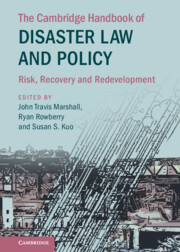Book contents
- The Cambridge Handbook of Disaster Law and Policy
- The Cambridge Handbook of Disaster Law and Policy
- Copyright page
- Dedication
- Contents
- Figures
- Maps
- Tables
- Contributors
- Foreword: Current Trends in Disaster Law and Policy
- Acknowledgments
- Introduction
- Part I Critical Perspectives on the Evolution of Disaster Law and Policy
- Part II Effective Governance as an Imperative for Responsive Disaster Law and Policy
- Part III Law’s Role in Promoting Hazard Mitigation: Intergovernmental, International, National, and Local Approaches
- Part IV Private Sector Initiatives to Promote Disaster Resilience and Recovery
- Part V Lawyers As Disaster Law and Policy Leaders: Training for Students and Guidance for Practitioners
- 24 Creating Blueprints for Law School Responses to Natural Disasters
- 25 Law and Lawyers in Disaster Response
- Part VI Cultural Heritage Protection and Cross-Disciplinary Opportunities for Advancing Disaster Law and Policy
- Part VII Disasters and Vulnerable Communities
24 - Creating Blueprints for Law School Responses to Natural Disasters
from Part V - Lawyers As Disaster Law and Policy Leaders: Training for Students and Guidance for Practitioners
Published online by Cambridge University Press: 27 October 2022
- The Cambridge Handbook of Disaster Law and Policy
- The Cambridge Handbook of Disaster Law and Policy
- Copyright page
- Dedication
- Contents
- Figures
- Maps
- Tables
- Contributors
- Foreword: Current Trends in Disaster Law and Policy
- Acknowledgments
- Introduction
- Part I Critical Perspectives on the Evolution of Disaster Law and Policy
- Part II Effective Governance as an Imperative for Responsive Disaster Law and Policy
- Part III Law’s Role in Promoting Hazard Mitigation: Intergovernmental, International, National, and Local Approaches
- Part IV Private Sector Initiatives to Promote Disaster Resilience and Recovery
- Part V Lawyers As Disaster Law and Policy Leaders: Training for Students and Guidance for Practitioners
- 24 Creating Blueprints for Law School Responses to Natural Disasters
- 25 Law and Lawyers in Disaster Response
- Part VI Cultural Heritage Protection and Cross-Disciplinary Opportunities for Advancing Disaster Law and Policy
- Part VII Disasters and Vulnerable Communities
Summary
Natural disasters are becoming more common and destructive. There is a critical need to build accessible legal services for vulnerable populations that suffer disproportionately from natural disasters. Law schools, legal clinics, and law professors are well-positioned to serve vulnerable and marginalized communities and can address the issues of poverty and race that exacerbate the harm caused by natural disasters. Access to justice and civil legal aid after natural disasters should be rooted in preparedness and planning before the disaster. Understanding the nature of natural disasters, the ecosystem of response systems, existing networks, common legal issues, and the typical arc of recovery will help law schools, legal clinics, and lawyers prepare and plan for response. The models and lessons discussed in this chapter may help provide increased post disaster legal services to vulnerable people to empower them with confidence and tools to serve their communities. This chapter builds on lessons learned from previous natural disasters and offers information and insights on responsive program design, professionalism, and disaster response systems. Building a framework for institutional responses in the legal academy can advance and improve access to justice for vulnerable communities recovering after a disaster so that they can survive, rebuild and return home.
- Type
- Chapter
- Information
- The Cambridge Handbook of Disaster Law and PolicyRisk, Recovery, and Redevelopment, pp. 389 - 407Publisher: Cambridge University PressPrint publication year: 2022

